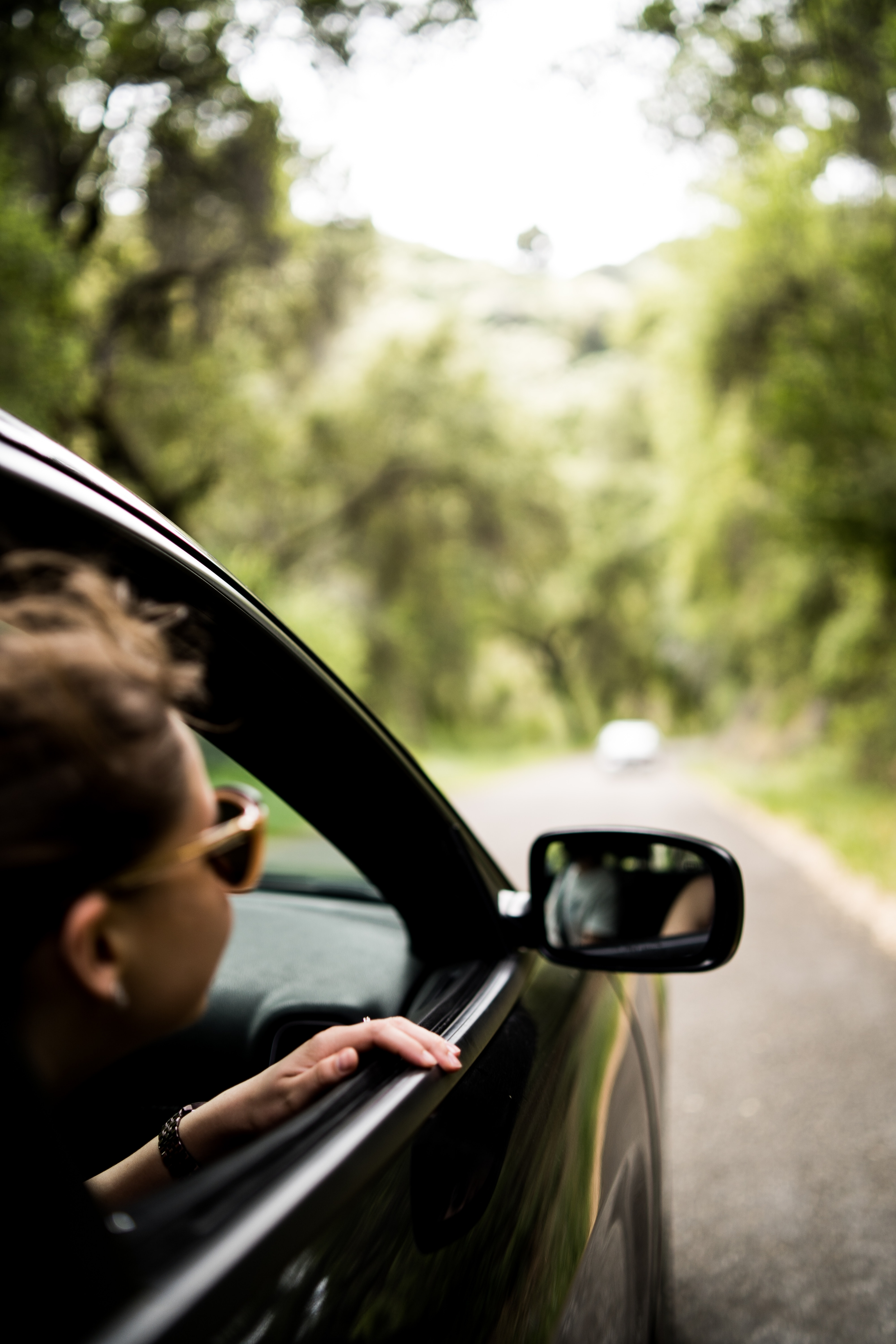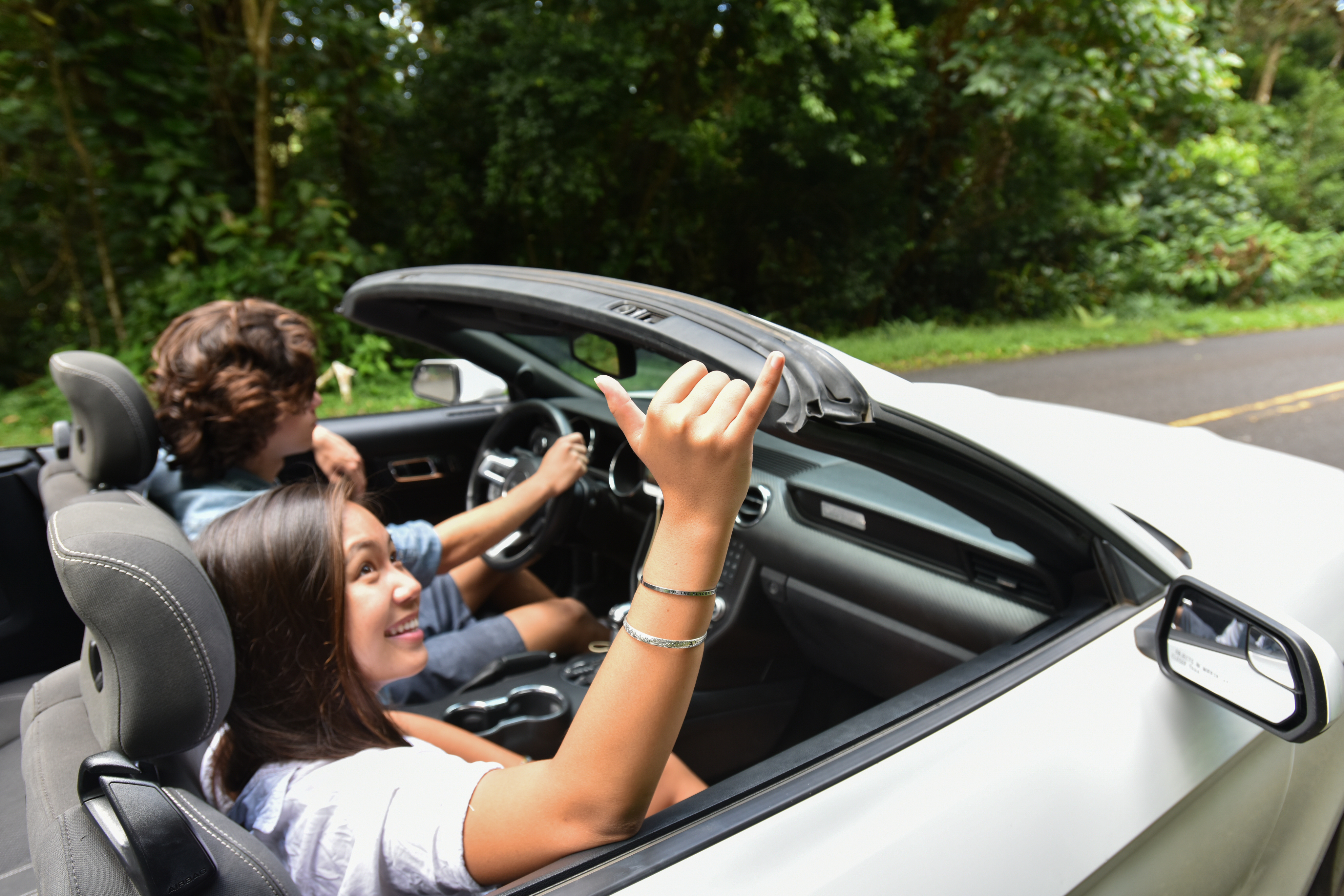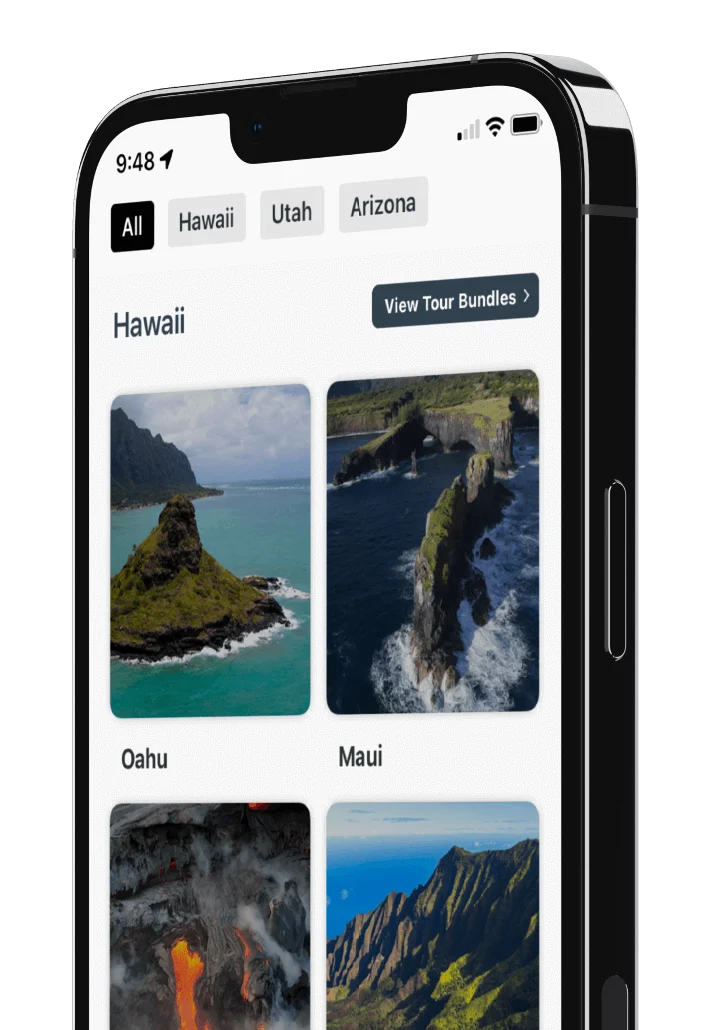
The Ultimate Zion National Park Travel Guide

Why Visit Zion National Park?
Come with us to explore Utah’s first National Park. Follow the path of the native peoples and Mormon settlers. Trek through rugged deserts and slot canyons. Pass under weeping stones into verdant oases. Explore cool ponderosa pine forests among the mountain tops.
Zion National Park is so much more than just mesas and canyons—and more visitors are discovering that for themselves. As the third most popular national park in the nation, Zion saw 4.5 million visitors in 2019 alone.
After all, who can resist the majesty of Zion? Of its soaring pink and gray sandstone? Of its crisscrossed mesas? Of its ephemeral falls?
The stunning geology in Zion resulted from about 150 million years of sedimentation and uplift. Thanks to these events, the sandstone features in Zion are among the tallest and most spectacular in the world. In Zion, there are nine distinct visible rock layers, each with its own unique color, fossils, and history. With Shaka Guide, we’ll not only show you all of these beautiful features, but we’ll also help you to understand them, through stories of geology, history, and biology. Once you arrive, you’ll agree—in all of the world, there’s truly nowhere else like Zion.
The park has four distinct regions. These are:
- Zion Canyon
- Kolob Canyons
- Kolob Terrace
- East Zion
Many visitors to the park are only familiar with Zion Canyon, the park's most popular section. However, Zion National Park is divided into four regions, each with its own unique environment. These regions are Zion Canyon, Kolob Canyons, Kolob Terrace, and East Zion. While many visitors will only choose to visit Zion Canyon, if you’re taking Shaka Guide’s Zion National Park Tour, we’ll give you the chance to explore all of Zion.
Where is Zion?
Located in southwestern Utah, Zion is just two hours from the Grand Canyon and less than three hours from Las Vegas. Even if you’re just passing through, there’s plenty of adventure to be had out here!
Getting to Zion National Park
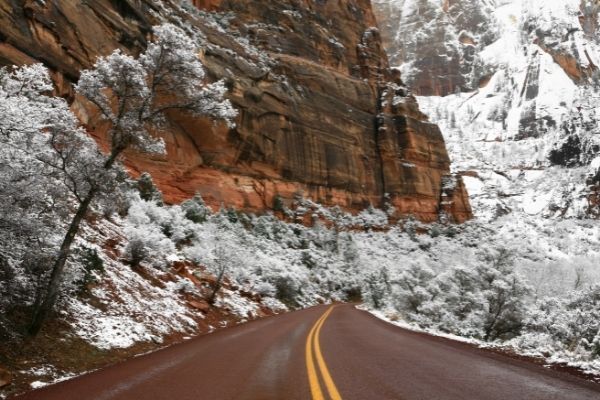 by ImagineGolf by Getty Images
by ImagineGolf by Getty Images
Located on UT-9 in Washington County, Utah, visitors from the West will pass through Hurricane to begin their journey, while visitors from the East will begin at Mt Carmel Junction, just about 20 minutes north of Kanab.
Airports Near Zion National Park
- SGU Regional Airport-47 miles, 1 hr, St. George, Utah
- Cedar City Regional Airport-61 miles, 1 hr 10 minutes, Cedar City, Utah
- McCarran International Airport-173 miles, 2 hr 50 minutes, Las Vegas, Nevada
Cities Near Zion National Park
- Hurricane, Utah-24 miles, 30 minutes
- St.George, Utah-42 miles, 55 minutes
- Cedar City, Utah-58 miles, 1 hr
- Las Vegas, Nevada-168 miles, 2 hr 40 minutes
- Salt Lake City, Utah-316 miles, 4 hr 20 minutes
Getting Around Zion National Park
Mandatory Shuttle Service
Since 2000, Zion has implemented a shuttle service in an effort to ease park congestion. Shuttle season in Zion is from February to November (and again at Christmas). During shuttle season, personal vehicles are not permitted in Zion Canyon, so visitors will need to catch a shuttle.
There are two shuttles in Zion, the Zion Canyon Shuttle and the Springdale shuttle. The Zion Canyon Shuttle is free and runs from 7 a.m. to early evening. The Zion shuttle ferries visitors from the Zion Canyon Visitor Center all the way to the Temple of Sinawava—Zion Canyon’s final stop. There are nine stops along this route altogether, and the shuttles run both ways. Shuttle stops occur at each stop every 10-15 minutes. You may get on and off at any point. See when to visit for a more detailed schedule or check the Zion NPS website for the most up-to-date shuttle schedule.
The second shuttle is the Springdale shuttle. This shuttle runs visitors from the town of Springdale to the Zion Canyon Village. From there, it is a short walk to the pedestrian entrance. For visitors parking in the town of Springdale, you will catch this shuttle to enter Zion before embarking on the Zion Canyon Shuttle. There are nine stops located inside the town. There is no fee to use the Springdale shuttle.
Where to Stay In and Around Zion National Park
You know what they say, “location, location, location.” Well, it’s no different in Zion. While there’s always some variability, generally, the closer you are to Zion Canyon, the more expensive accommodations become. These are some of the options you have for accommodations, from closest to furthest.
Stay Inside Zion Canyon
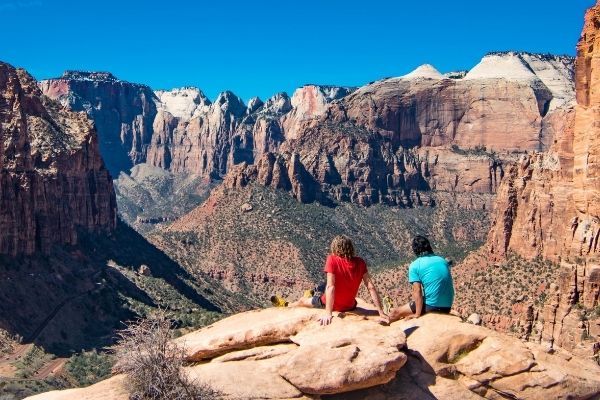 by Thaddeo from pixabay
by Thaddeo from pixabay
For those who want to maximize their time inside the park and can book far in advance, the Zion National Park Lodge is for you. Zion National Park Lodge is the only hotel inside of the park, and is, understandably, quite popular. For the busy season, these rooms may be booked out months prior, so it’s important to plan ahead. Reservations are usually around 230 dollars a night, depending on the season, and can be made up to 13 months in advance.
Stay in Kolob Terrace
Though few, there are some accommodations in Kolob Terrace. Staying here will offer you a scenic retreat in the beauty of Zion without all of the hustle and bustle of Zion Canyon.
There are two places available for visitors to stay: Lazalou Zion Retreat and Zions Tiny Oasis. These luxurious tiny home rentals begin at about 400 dollars a night. If you are looking for something less extravagant, there are a few cabins for rent near Kolob Reservoir, located at the top of the mountain.
Stay in Springdale
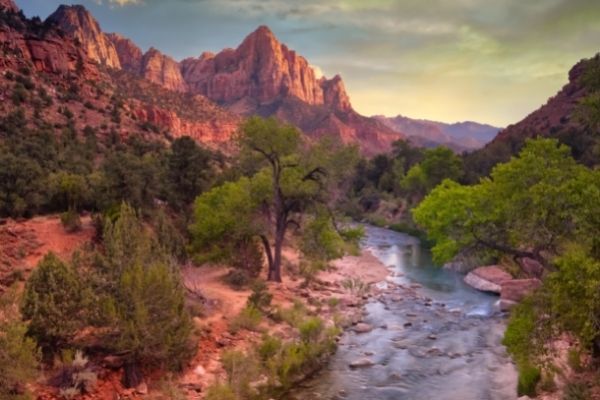 by Leemus by Getty Images
by Leemus by Getty Images
Not all of us can book our vacations 13 months in advance, so for the rest of us, Springdale offers the closest last-minute accommodations near Zion Canyon. And, no fear, there are plenty of selections to choose from. Springdale is quite literally the gate to Zion, so for those prioritizing convenience, this is the place to look. Springdale is also a hub of restaurants, culture, and activities for those looking to have everything within walking distance. After all, you’ve driven enough! For hotels, you’ll be looking at around 300 dollars a night. And for Air B&Bs, their prices are usually similar, though they sometimes go as low as 200. Just don’t forget all of the cleaning fees!
Stay in Virgin/Rockville
There are just a few hotel options in Virgin and Rockville, two tiny towns just 10-20 minutes outside of Zion Canyon. The rates here are quite a bit cheaper, usually 50 to 100 dollars less than in Springdale. If a twenty-minute drive is worth it to you, consider saving a few bucks by staying in Springdale or Rockville for anywhere from 150-250 dollars a night. Be aware, though, when we say tiny town, we mean it! There are only three restaurants in Virgin and none in Rockville, so if you’re looking for a peaceful, quiet stay, this is the place for you!
Stay in La Verkin/Hurricane
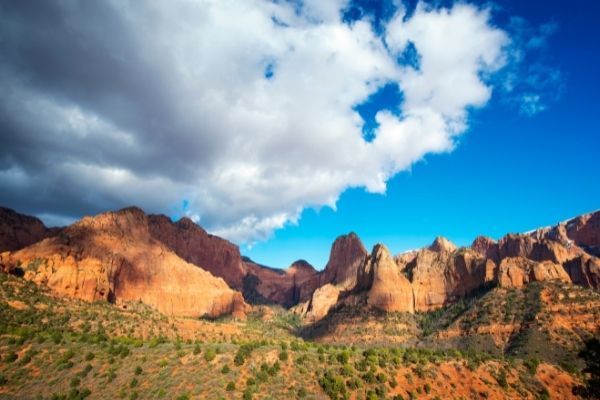 by Anita Sagastegui from Getty Images
by Anita Sagastegui from Getty Images
La Verkin and Hurricane are located about 30 minutes away from Zion Canyon but are by far the most economical choices. Hotels around this area can cost anywhere from 100-200 dollars on average. Additionally, for those who choose to stay in this area, there are several restaurants and convenience stores located nearby. For many, this will be the best of both worlds, offering affordable prices and a convenient location.
Camping in Zion National Park
Looking to make a genuine connection with nature while visiting Zion? Because the area around Zion remains relatively warm well into November, camping can be surprisingly pleasant for the majority of the year.
So where should you pitch your tent in Zion? South Campground is probably the best place to camp in Zion, for both convenience and comfort. The campground is spacious and shady and is located just past Springdale by the South Gate entrance. The biggest bonus to staying here? No line-up for the gate check in the morning! Reservations for South Campground are strongly recommended. Book reservations up to two weeks in advance at www.recreation.gov.
If South Campground is full, consider staying at Watchman Campground, just a few minutes from South Campground. Reservations for Watchman open six months in advance, so if waiting until two weeks before your trip seems to cut it a little too close for comfort, this is a great option.
Both South Campground and Watchman Campground will run you about 20 dollars a night for tents only, and 30 dollars for electricity hookups ( available at Watchman only). Other camping options include Zion Canyon Campground, Zion River Resort, Hi-Road Campground, Lava Point Campground, and Kolob Reservoir.
Glamping in Zion
But what if camping seems a little too, erm, rustic for your taste? Then how about glamping? It’s just like camping...but glamorous! Glamping tents may feature beautiful furnishings, stove, AC, patios, private bathrooms—even housekeeping! The prices and amenities included vary wildly in Zion, and there are many different glamping options scattered throughout the area. They can be a little harder to find, but trust us—there’s no shortage of choices! For those looking for a glamping experience with fewer frills, consider the following: Zion Glamping Adventures, Zion Wildflower Resort, Zion Backcountry, Whispering Pines, Gooseberry Mesa Yurts, Zion Weeping Buffalo, and Zion Ponderosa Ranch Resort. For those who are looking for an unforgettably luxurious experience, Open Sky Zion and Undercanvas Zion offer lavish glamping accommodations.
When to Visit Zion National Park
Zion National Park is open every day of the year, including holidays. However, certain park services may be unavailable during holidays. Generally speaking, facilities, e.g. the visitor center, are open from 8 a.m. to 5 p.m. During holidays and in wintertime, these hours may be reduced.
Zion’s shuttle hours vary month to month. Aside from the last week of December, the first shuttle leaves the visitor center at 7 a.m. and the last shuttle out leaves the Temple of Sinawava at 7:15 p.m. During late summer, the last shuttle departs one hour earlier, at 6:15 p.m. It’s important to check the daily shuttle schedule while in Zion to confirm as the schedule may change at any time.
RELATED: When's the Best Time to Visit Zion National Park?
Weather in Zion National Park by Season
After carefully planning our perfect trip to Zion, the last thing we want is to have our plans go awry due to bad weather. While Zion rarely gets rained out (only 68 days of rain a year!), it is very possible that you will encounter a flood watch or warning during your visit. In this case, many canyons and riverside hikes will become unsafe. Additionally, after snowfall, parts of Kolob Terrace and Kolob Canyons may be closed. It is important to have backup plans in place and to respect mother nature’s warnings. No hike is worth risking our safety!
Additionally, Zion’s temperatures vary wildly. From day to night, summer to winter, and lowlands to plateaus, Zion can swing from sweltering to chilling to everything in between. If you are traveling in the summer, anticipate triple-digit days. In the winter, be prepared for snow. No matter the season, be sure to bring plenty of water as well as temperature-appropriate attire for your trip to Zion. Zion is very arid and this low humidity means visitors can quickly become dehydrated. The best way to ensure a great time in Zion is to come prepared!
Holidays
This may go without saying, but that extra vacation day that you get for Labor Day? You might want to just save that. Holidays in Zion can get very crowded...and expensive! Basically, everyone has the same idea of traveling to Zion for holidays, and that means that an already-crowded park swells with people on these long weekends. For instance, on the fourth of July in 2019, Zion saw 94,000 visitors over that weekend alone. That’s a lot of people! If you’re very patient, it may still be worth it to visit Zion during the holidays, but expect long lines for shuttle rides and popular hikes such as Angel’s Landing.
Spring
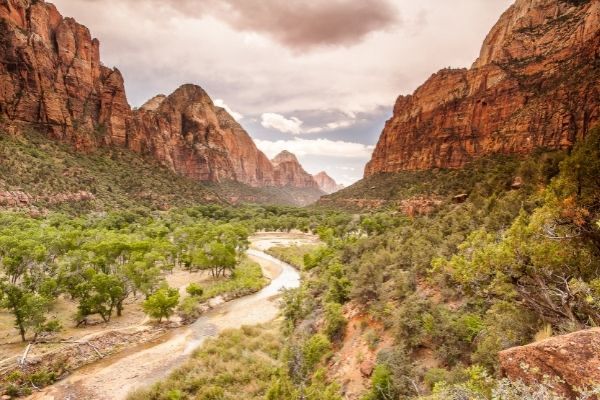 by CarlosChavezPhotography by Getty Images
by CarlosChavezPhotography by Getty Images
As the winter snows begin to melt, Zion enjoys warm days, cool evenings, and the return of life to the canyon. Daytime temperatures remain warm, climbing from the low 60’s in early spring to high 80’s towards May. Nighttime temperatures tend to stay a bit chilly, falling as low as the 40’s or 50’s. While it might be a bit too cool for trekking through the brisk water of The Narrows, Spring is an excellent time to enjoy some of Zion’s longer and warmer trails, or to take on an extended backpacking trip.
Zion experiences the most precipitation during late winter and early spring. Unfortunately, this means that certain areas, like The Narrows, may occasionally be closed due to snowmelt and rising water levels. The good news is that this precipitation brings to life the park’s ephemeral falls and flowers. Many of Zion’s plants hurry to take advantage of these precious seasonal rains. Flowers like the Desert marigold, Slickrock paintbrush, and Claret cup cactus speckle Zion in beautiful reds and golds.
As far as crowds go, March and April are relatively peaceful, while the month of May gets very crowded. While the weather is fantastic in May, be prepared to rub elbows with tourists, as this is the start of Zion’s peak season.
Summer
 by Victor Lee from Getty Images
by Victor Lee from Getty Images
In summer, Zion is the hot spot to be. And that’s meant both literally and figuratively. Temperatures can easily soar into the triple digits, and crowds from all over rush in for fun under the desert sun. For many parents with schoolchildren, this will be their summer vacation, and popular and shorter trails can get pretty crowded with families. This is especially true in June and July. If you really want to visit Zion during the peak summer season, consider visiting in late August. This month sees a slight drop in the number of visitors as well as temperatures. Be aware that summer in Zion is also known as the monsoon season. Be sure to check the forecast regularly for heavy precipitation and flash flood watches.
If you are looking to avoid crowds or paying premium prices, summer in Zion may not be for you. For those looking to hike Zion’s most popular trails, such as Angel’s Landing, expect to practice a lot of patience as you make your way through the crowds.
On the upside? Summertime in Zion is a great time to hike through shaded slot canyons, raft down the Virgin River, or visit Zion’s higher elevation attractions. My personal recommendation? Take advantage of a Shaka Guide secret and visit some of the lesser-known, cooler sections of Zion National Park—like Kolob Canyons and Kolob Terrace. Temperatures up at the top of Kolob Terrace can be as much as ten degrees cooler, and most visitors don’t even know about these hidden gems.
Fall
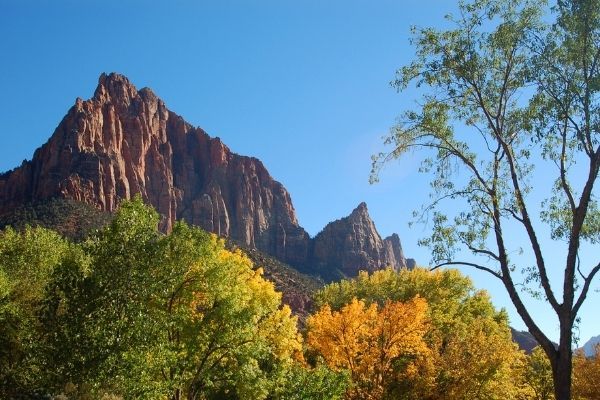 by Tigerone from Getty Images
by Tigerone from Getty Images
Ahh, fall in Zion National Park. No matter your travel plans, fall is a wonderful time to visit Zion. As the temperatures begin to cool off and the crowds begin to dissipate, Zion becomes a much more navigable place. September still sees temperatures regularly rise into the 90’s, but the evenings are beginning to grow a bit cooler, sometimes dropping as low as 60 degrees. The beginning of September can still be very crowded, with many families trying to squeeze in a last-minute summer vacation. The end of September starts to see the crowds diminish, and by November, Zion is a place of peace once again. Even in November, Zion is fairly warm during the day, with highs in the mid 60’s. Nightime in November finally sees some real chills, though, with temperatures sometimes dropping below 40 towards the end of the season.
As the days grow shorter in Zion, the leaves begin to change, and reds, golds, and purples begin to color the park. Higher elevations see fall colors begin to emerge in mid-September, while lower elevations will have to wait another month—until about the middle of October.
Most visitors agree—the best time to visit Zion is in Fall. The weather, the prices, and the crowds are all very reasonable. An added bonus? All park services, including the museums, continue until November, meaning visitors during the fall won’t have to miss a thing. Except for the crowds, that is.
Winter
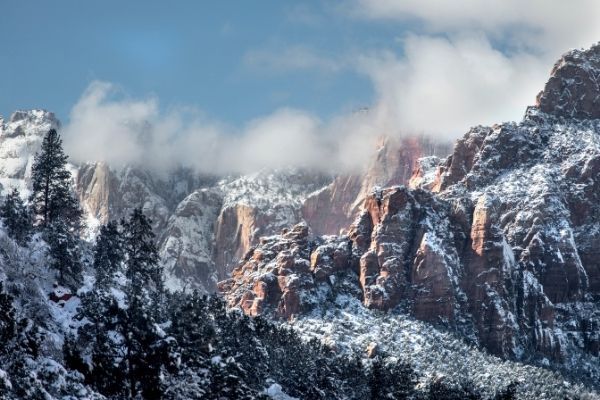 by MichaelJust from Getty Images
by MichaelJust from Getty Images
Winter is by far the least popular season to visit Zion. But for those looking for a sense of peace and isolation, there really is no better time to visit. Zion still has plenty of gorgeous scenery to offer its wintertime visitors. In fact, there’s nothing quite like waking up to a snow-dusted canyon or driving up to see the frosted evergreens high on the mountain. Just be sure to come equipped with some good snow boots and a heavy jacket, because things can start to get pretty chilly around mid-December. Expect temperatures to reach the mid-fifties in the day and drop to around 30 degrees at night.
For visitors traveling to Zion in winter, expect some park closings to accompany the icy temperatures. While Zion Canyon will be open throughout the year, higher elevations such as Kolob Terrace and Kolob Canyons may sometimes be closed due to snowfall. Additionally, some hikes, such as Angel’s Landing, may be too dangerous to attempt due to icy conditions. Winter months see the most precipitation of any season in Zion, so come equipped to hike through snowy and rainy weather.
There are a few other perks to visiting Zion in the winter as well. Winter is the only season in which travelers can drive their own vehicles through Zion Canyon. That’s right, no shuttle buses during winter! (Aside from Christmas week.) Plus, winter is by far the cheapest season to visit, so it may just save you a bit of stress, as well as a few dollars, to plan your trip to Zion as a winter getaway.
Things to Do in Zion National Park
1. Driving Tours: Shaka Guide's Zion National Park Tour
While Zion Canyon Scenic Drive is closed to personal cars during the busy season, winter visitors are free to drive themselves through the canyon. Outside of Zion Canyon, there are plenty of other beautiful vistas for drivers to visit year-round. For those looking for a cruise with views, we have three fantastic options.
Our first recommendation is one of the most scenic drives in Zion National Park—Kolob Terrace. This 40-minute scenic drive climbs up about 5000 feet in elevation, winding its way from desert prickly pear and cottonwood trees up through mountain sagebrush and ponderosa pines. Take the drive all the way up to the 8,000-foot high summit to overlook black lava fields, cinder cones, and wind-worn hoodoos.
Though short, Kolob Canyons offers visitors several scenic pullovers and a break from the hustle and bustle below. This section of the park features more visible rock formations than anywhere else in Zion. This is a particularly excellent stopover if you find yourself to the west of Zion Canyon.
Finally, in East Zion, drivers can enjoy beautiful viewpoints unlike anything else in the park. This scenic drive will take visitors along sky-high hairpin turns, through the historic Mt.Carmel tunnel, and out into miles of stunning slickrock. Definitely a must-see for visitors looking to experience the best of Zion.
Check out our Zion National Park Tour to visit ALL three of these regions and Zion Canyon.
2. Hike
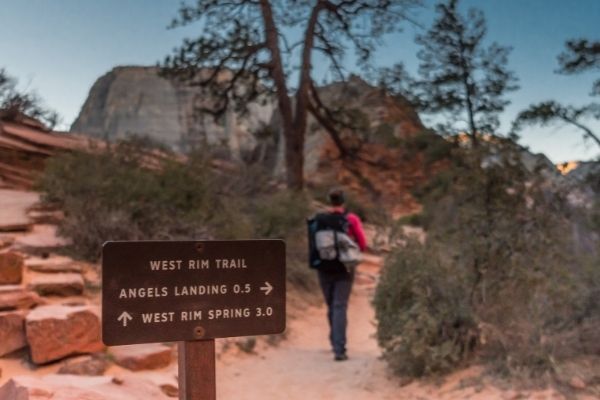 by KellyVanDellen
by KellyVanDellen
For those looking to take on a few good hikes, Zion is certainly the place to be. In fact, Zion is home to so many fantastic hikes, you’ll be hard-pressed to find ones you don’t want to do. We’ve curated a list of what we think are the best hikes that Zion has to offer:
- Angel’s Landing-Zion Canyon (advence reservations required)
- Emerald Pools Trail-Zion Canyon
- The Narrows-Zion Canyon
- Canyon Overlook Trail-East Zion
- Timber Creek Trail-Kolob Canyons
- Cave Valley Trail-Kolob Terrace
- Northgate Peaks Trail-Kolob Terrace
Feeling excited for what’s to come? Feel free to salivate over your amazing Shaka Guide Itinerary. For a complete list of available hikes, check out the highlights in the tour app, and for more thorough trail descriptions, take a look at our hiking guide.
3. Backpack
Zion is a backpacker’s paradise. With dozens of backpacking sites and multiple camping areas, there are plenty of options for those travelers looking to form a deeper connection with Zion’s wilderness.
Before you start packing your camping gear, there are a few things to note. First, all backpackers must have a valid wilderness permit and must stay overnight in their designated wilderness backpacking area. Secondly, reservations for backpacking sites can be made either online or in-person on a first-come-first-served basis. Half of the sites will be made available for online booking, while the other half will be available for in-person inquiries only. If you want to make a reservation for one of these sites online, sites for the month open for reservations on the fifth of the month prior. It is not uncommon for these sites to fill up within minutes of opening. Online reservations can be made at the Zion Wilderness Reservation site.
Permit prices are as follows:
- $15.00 for 1 to 2 people
- $20.00 for 3 to 7 people
- $25.00 for 8 to 12 people
Zion has several backpacking trails for visitors to choose from.
- Wildcat Canyon and Connector Trails-Zion Canyon
- Virgin River Narrows-Zion Canyon
- La Verkin Creek Trail- Kolob Canyons
- West Rim Trail-Kolob Terrace
- Hop Valley Trail-Kolob Terrace
- Southwest Desert Trails-Anasazi Way
- East Rim Trails-East Zion
For further details on these wilderness hikes, check out our hiking guide.
4. Zion Canyon Visitor Center
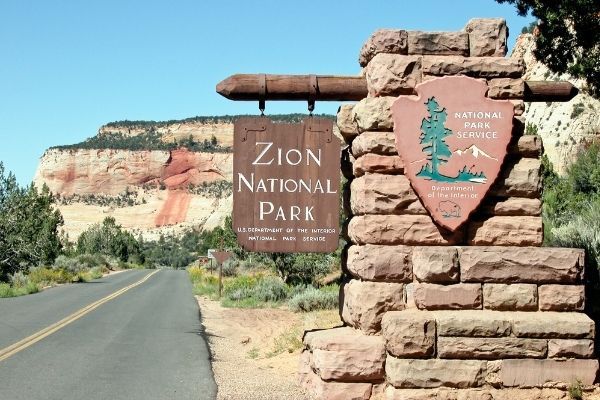 Gagliardi Photography
Gagliardi Photography
When you arrive at Zion Canyon Visitor Center, take a chance to read the information plaques, talk to the rangers, and grab a map before you hit the trails. While at the center, visitors should also review the schedule for ranger-led activities. These activities—including ranger walks—allow visitors to learn from the experts while hiking some of Zion’s most popular trails. At the end of the day, when you’re heading back out, don’t forget to grab some souvenirs to take home with you from the gift shop!
5. Zion Human History Museum/Ranger Tours
Visitors to the Zion Human History Museum can escape the weather and browse through over 300,000 permanent exhibits on the human and geologic history of Zion. The museum also shows a free 22-minute film on Zion National Park’s history, played every half hour.
But what’s the number one activity at the Human History Museum? Definitely the ranger talks. Visitors are encouraged to enjoy a ranger-led discussion held on the back patio of the museum. These informative talks are free, with no reservation required. Take the opportunity to learn about Zion’s history, geology, and biology from the park’s foremost experts!
6. Swim
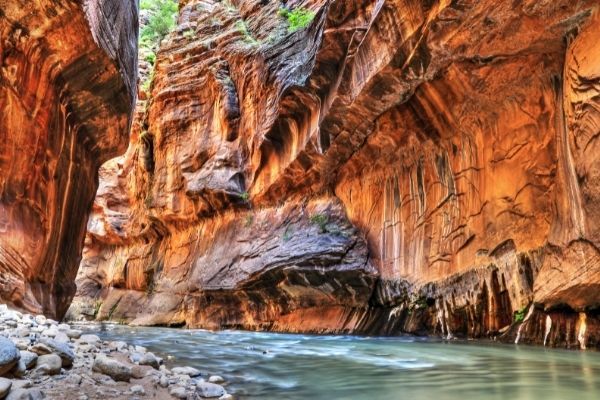 by GuiMesquita from Getty Images
by GuiMesquita from Getty Images
Thanks to the Virgin River, visitors to Zion can enjoy some swimming even in the desert. But don’t pull out that swimsuit just yet! There are some important water safety facts that all swimmers and visitors should know.
Since the summer of 2020, Zion’s Virgin River and its tributaries have been experiencing toxic cyanobacteria blooms. Side effects of exposure in humans are usually mild and may include skin irritation or gastrointestinal distress. Exposure of these cyanobacteria in dogs, however, has a high degree of fatality. Keep all pets away from the water, and, in the case of exposure, rinse the animal’s fur and skin immediately. If swimming, humans must not drink or submerge their heads underwater, as doing so can potentially cause kidney or liver damage. Visitors can check the current safety warnings at the Zion NPS website.
Where to Swim in Zion National Park
Well, now that the scary part is out of the way, where do people who want to swim need to go? Well, there’s a couple of places to take a dip in Zion. You can find them listed below. For more information on the Pine Creek Trail, be sure to check out our hiking guide.
- Kolob Reservoir-Kolob Terrace
- Pine Creek Trail- East Zion
- Virgin River Swimming Hole-Canyon Junction Shuttle Stop
7. Rafting/Kayaking
Looking for some real excitement? How about catching an adrenaline rush by rafting down the white rapids of the Virgin River? If you’re an experienced rafter, you can pick up your wilderness permit from the Zion Canyon Visitor Center and go it alone. For those who prefer a guided tour, usually, the tour guide will take care of your wilderness permit for you.
8. Canyoneering
For those who long for a sense of adventure and exploration, Zion is a canyoneering paradise. Swim, scramble, crawl and climb your way to new and exciting sights and heights. Many of Zion’s canyoneering routes are beginner-friendly, but for those who would love an expert’s advice, Zion has no shortage of guides willing to take you on the adventure of a lifetime. Just don’t forget your wilderness permit!
Consider some of these popular locations in Zion for your canyoneering adventure.
- The Subway-Kolob Terrace
- Orderville Canyon-Zion Canyon
- Mystery Canyon-Zion Canyon
- Pine Creek-East Zion
9. Rock Climbing
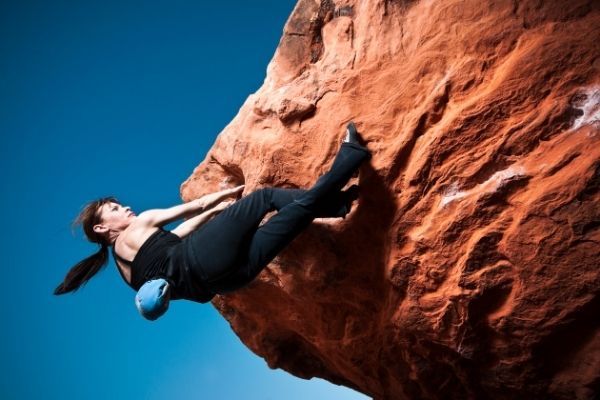 by DarrenMower from Getty Images
by DarrenMower from Getty Images
Zion National Park is renowned for its soaring sandstone cliffs, sometimes rising as high as 2,000 feet. Needless to say, Zion abounds with excellent climbs, both overnight and single day. Many of the climbs inside the park are higher-difficulty, so be sure to check the recommended skill level before you head out. For those who are a little wary about breaking into rock climbing, consider trying rappelling, instead. It’s all the fun of the descent—without the long climb! Looking to simplify the experience? Grab a guide to take care of all the prep work, research, and gear rental. Then, all you have to do is climb!
10. Biking
There is only one trail available for biking inside Zion National Park, and that’s the Pa’rus trail. This is a paved riverside trail located just past the visitor center and is just shy of 2 miles each way. Additionally, avid cyclists can enjoy biking Zion’s many scenic drives, including the Zion Canyon Scenic Drive inside the main canyon.
Outside of the park, there are several thrilling areas for mountain biking, including the recommended Gooseberry Mesa Slickrock Trails. It’s considered one of the best technical mountain biking trails in the United States.
11. Horseback Riding
From March to October, visitors have the option to explore Zion in much the same way that the pioneers did—on horseback. The horseback trails in and around Zion are slow-paced and beginner-friendly. There are several companies and ranchers around Zion offering guided horseback rides for those hoping to hit the dusty trail.
12. ATV
While there is no ATV riding inside of Zion National Park, there are several areas nearby for those looking to crank up the throttle. Sand Hollow and Coral Pink Sand Dunes State Parks are excellent options for those looking to tear up some sand. Some tours even offer sandboarding or sand-sledding add-ons!
13. Visit a Ghost Town
The abandoned 19th-century ghost town of Grafton is famous as the perfect setting for old western films and excellent selfies. For all you movie-buffs, Grafton served as a filming location for such great classics as In Old Arizona and Butch Cassidy and the Sundance Kid. Beyond inspiring filmmakers, it is also thought to be the most photographed ghost town in the west!
Where to Eat in Zion
Feeling famished after a day full of hiking? There are plenty of places around Zion to sit down for a delicious meal. Springdale, right outside of Zion’s south gate, has no shortage of places to eat. If you’re feeling ravenous and want a diverse menu, hit up Oscar’s Cafe. We can guarantee you won’t leave hungry. Another Springdale favorite is Thai Sappa, featuring a menu filled with fresh, balanced Thai flavors. If you’re staying in La Verkin, be sure to check out Stage Coach Grille, featuring fresh locally-sourced beef. And if you’re heading through Hurricane on your way to or from the airport, you have to swing by Cross Country Diner. Trust us, you will not be disappointed.
There is only one spot to eat in the park, and that’s Zion Lodge’s Red Rock Grille in the Zion Canyon region of the park.
Budgeting
Activity Costs
So, how much will it cost you to enjoy some of those thrilling guided adventure tours? While they vary from company to company, we can provide you with some estimates of what to expect.
ATV Rental
- $300-600 per vehicle, all-day, unguided (prices vary depending on vehicle type)
- $150-200 pp, 2-hour guided tour
Horseback Riding
- $100 pp, 3-hour guided tour
- $50 pp, 1-hour guided tour
Mountain Biking
- $75 per full-suspension bike, all-day, unguided
- $250 pp, all day, guided tour
Rock Climbing
- $40-60 per day, gear only, unguided
- $200-300 all day, guided tour
Canyoneering
- $40-60 per day, gear only, unguided
- $200-300 pp, all day, guided tour
Kayaking/Rafting
- 60 per kayak all day, unguided
- 30-100 pp all day, guided tour
Shaka Guide Driving Tour
- $9.99 for the Zion National Park Tour
- $19.99 for the Moab Bundle
- $29.99 for the Utah & Mighty 5 Collection
Transportation Cost
Most visitors choose to drive themselves through Zion. For those renting a vehicle, car rentals from St.George airport can get quite expensive. For a budget car, expect anywhere from 70-100 dollars a day after taxes and fees. The price of rentals from Las Vegas is generally about the same to slightly more expensive, anywhere from 80-110 dollars a day. Gas tends to be slightly above the national average near Zion. If driving from Las Vegas to Zion National Park, expect anywhere from 30-50 dollars round-trip in gas alone.
Lodging Cost
The price of your accommodations will vary based on proximity to Zion Canyon, season, and amenities. For primitive camping, prices start at about 20 dollars per night. Not a bad deal for a room with a view. For luxury glamping, however, the prices can soar to over 600 dollars a night. If you’re traveling in spring through fall, expect anywhere from 200 to 300 dollars a night for a 2-3 star hotel, depending on how close you are to the south gate of Zion.
Meal Costs
Anticipate anywhere from 10-20 dollars per person for lunch, and 15-25 dollars per person for dinner. Picnic lunches are an excellent way to save some money and can lower your price to about 5 dollars per person.
Miscellaneous Expenses
- Narrows Gear Rental Package- $30 pp per day
- Bivy Permit-$15 (for all overnight climbs)
- Springdale Parking-$20 per vehicle per day
- Wilderness Permit- $15, up to two people
Additional Park Entrances
- Sand Hollow State Park,-1 non-residential vehicle, single day -$20
- Coral Pink Sanddunes Sate Park-1 vehicle, single day-$10
- Snow Canyon State Park-1 vehicle, single day-$10
Zion National Park FAQs
What’s the elevation of Zion National Park?
Zion National Park’s elevation ranges from 3,500 feet to 8,000 feet.
How far is Zion National Park to Bryce Canyon National Park?
It’s about 86 miles or a two-hour drive to Bryce Canyon.
Are there other state parks in the local area?
Yes, there are three state parks in close proximity to Zion. Coral Pink Sand Dunes is located 45 miles east of Zion, Sand Hollow is 39 miles to the Southeast, and Snow Canyon State Park is located 55 miles west.
Are pets allowed on any trails?
Pets are only allowed on the Pa-rus trail.
Will I have a cell phone signal in Zion?
Visitors should anticipate limited cell service becoming more unreliable as they proceed further inside the canyon.
Where can I get wifi in the park?
The Zion Canyon Visitor Center and the Zion Human History Museum both have free public wifi.
Where is the closest gas station to Zion National Park?
In Springdale, just one mile from the south gate entrance, there are two gas stations.
Is there a way to refill my water bottles?
There are multiple refilling stations in Zion Canyon and one in Kolob Canyons. There are none in Kolob Terrace or at East Zion. Fill up before you arrive.
Is there any free parking in Zion?
Yes, there is free parking available at the Zion Canyon Visitor Center. Expect to arrive before 8 a.m. if you hope to make use of Zion’s free parking. Later in the morning, the parking lot will be filled.
Conclusion
With so much to see and do, it’s easy to have a great time at Zion National Park. For the best experience possible, be sure you’re coming prepared with plenty of water, the right gear, and try to avoid peak times. If the crowds get a little overwhelming or the weather won’t quite cooperate, try to be flexible in your plans. Zion National Park is a surprisingly large park with plenty for visitors to discover.
Ready to plan your trip to Zion? Check out our Zion National Park Tour. With over a dozen stops and visits to all four sections of the park - you won't want to miss it!



